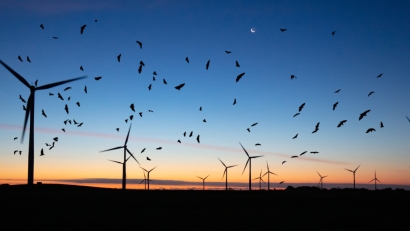
One key example of this is in France. Today, wind energy is the third largest source of electricity. And there is no slowing down. According to the Energy Transition for Green Growth Act (2015), 40% of electricity consumption should be from renewable sources by 2030.
At the same time, achieving this level of growth becomes a balancing act that needs to be adhered to, specifically with regards to the environment and biodiversity.
Which brings us to bats.
Pending the outcomes of mandatory, environmental impact studies during the development stage, some French wind farms can be subject to environmental restrictions that relate to avifauna species including bats.
The environmental restrictions enforced by the public regional agencies (DREAL) outline the operational curtailment that must be applied when various environmental conditions are met.
For the various bat species throughout France, these conditional requirements relate to their habitual behavior. Specifically, their foraging activities.
The criteria for bat curtailment states that if certain conditions such as time of the year, time of day/night, wind speed or ambient temperature are met, the impacted turbines must be stopped.
So what are the immediate solutions available to operators in order to comply?
Manual Intervention
One blanket solution is to perform manual stops during the affected time of year as soon as it goes dark and then restart, at first light.
The problem with this is that it ignores the other residing factors of air temperature and wind speed. Stopping turbines due to two of the four parameters limits the ability to capture lost energy.
It might be dark and within the time of year bat foraging has been identified, but if the wind speeds are higher than the threshold that would impact the local bat population, then that is potential energy being left on the table.
OEM SCADA Upgrade
Providing individual inputs at the SCADA level of each wind turbine can also be a method of compliance. However, because the OEMs hold the required technical proprietary knowledge for access and configuration, making a call to them each time the conditions arise, can cause a bottleneck in your workflow.
Automated Curtailment Operations
Another solution is to automate your controlled stops by using code to determine when all parameters are being met and execute the control command automatically.
The clear benefit here is you avoid all of the aforementioned. But you also remove human requirements to engage in a solution. Automating decisions at this level holds benefits that extend beyond the energy savings you make.
An example of how Green Eagle Solutions has executed this solution can be seen below:

Hardware + Software Solution
In addition to the automated code-based solution, there are some providers that offer dedicated avifauna detection systems. These typically include the installation of a detection hardware system on-site that recognises various species and executes commands to stop the affected turbines.
Making decisions on the above solutions should always come down to the specific needs and requirements of your site but also the goals and initiatives of your asset management strategy.
Perhaps in contradiction to scalability, installing yet another hardware device comes with the standard, human intervention issues, and costs. On-site installation, maintenance, updates and logistics are all factors that impact OPEX.
The factors to consider come down to the size of your projects within affected areas and the level of input needed to drive the right outcomes.
For example, for smaller sites with fewer turbines, manual intervention to meet the curtailment regulation might be a more feasible option.
Whereas for larger sites which are part of growing portfolios, having automated curtailment operations embedded in your asset management strategy removes the need for additional hardware to be placed on site, and the resource costs associated.
This also enables your operations team to focus their time and efforts on revenue generating activities.

